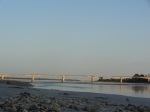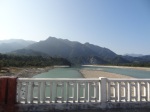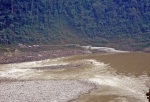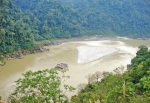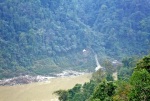THE MURDER IN 1911
Captain Neol Williamson was the Assistant Political Officer at Sadiya in the beginning of the 20th century and wedded to the ideas of British imperialism thoroughly. Within a very short time of his appointment, he toured into the interiors of the north-eastern hills and very often crossed the line of his jurisdiction. In the year 1908, Williamson toured the Pasi, Gallong and Minyong village around the present day Pasighat. In the following year he again made the tour in Lohit valley, this time going beyond the ’Outer line’. He also toured the Abor hills going along the course of Dihang river and went upto Kebang village. During this tour, he was accompanied by Colonel D.M. Lumsden and W.L.B. Jackman, a member of the American Mission at Sadiya. Williamson and his party could not go beyond the Kebang Village due to an inter-tribal war between the Pangis and the Minyongs.
The main objective of these tours was to gather detailed knowledge of the tribal land, explore the possibilities of the trade route through these hills to Tibet and to ascertain the extent of the Chinese influence in this area. The Adis, however, were always suspicious of these tours since during tours, they were not only required to work as porters but were also supposed to provide ration supply to the touring party without any substantial payment. Besides, the tribals were also haunted by a common sense of insecurity and humiliation. To a primitive people, with their distinctive native culture, institutions and values, the activities of the British amounted to a direct interference in their freedom and the imposition of an alien culture on them. Like any other tribal society which valued its freedom more than anything else, this was causing irritation among the Adis. The result was explosive, leading to the murder of Williamson and his party in 1911.
Noel Williamson was determined to penetrate into the hills with a view to fulfill his objective and once again, therefore, 1911, he penetrated again into the Mishmi hills upto Walong. There he noticed the Chinese flag at Menikari and was also reported the Chinese occupation of Rima. Noticing the Chinese activities In the Mishmi Hills he became concerned about the lot of the Abor Hills; immediately after his return from the Mishmi hills. He, therefore, chalked out a programme of tour into Abor hills. From the Chinese action he had seen in the Mishmi Hills, he at once realize the necessity of finding out the extent of the Chinese influence in these hills. Thus in 1911, Williamson ventured on another expedition of the Adi Hills that was to make an important landmark in the history of the North East.
Before proceeding to see the expedition of Williamson in 1911, let us have a look at the rules and regulations of the Government concerning such expeditions. the orders relating to the tours beyond the area of political control on the north-east border of India were summed up briefly in the rule that the sanction of the Local Government must first be obtained in all cases. When such tours were likely involve complications that could demand the sending of a punitive expedition, the tour could not be permitted without the prior permission of the Government of India. All the official records reveal that Williamson had failed to get the necessary sanction of the Government before he started his tour of the Abor Hills in 1911.
During this expedition, Willamson was accompanied by 34 Gurkhali coolies, 10 Miris, 2 orderlies and three servants. Besides, Dr. J.D. Gregorson, a successful doctor in medical charge of the European and native staff of an important tea garden at Tinsukia and Lakhimpur, who took a deep interest in the tribes of the Hills, also accompanied Williamson. On 18thMarch, 1911, the party reached Rottung and halted there for the night. During that night, some provisions and a case of liquor was stolen from the camp by some tribal people. Williamson asked the village people that the guilty were to be presented before him when he returned back from his journey. The naturally made the village people very angry, since Williamson had the guts to threaten the Adis in their own land. It is suggested that the plan to murder the entire party was discussed by the villagers the same night. This was even reported to Williamson, but he did not pay any attention to it. He was confident that the Adis would not attack him since as per the nature of the Adis, they are stronger in deliberation than in action. On the next day the party marched upto Pangi village and stayed there waiting for the arrival of the porters. On the 28th March, a Mising servant, Manpur, was sent back to Rottung with some sick coolies and some letters. Manpur, it was reported, told to the people of Rottung that he had come to take more sepoys into the hills so that the Adis could be punished. This false statement on the part of Manpur agitated the tribals who killed the four men and marched upto Pangi to take action against Williamson and his party.
On the fateful day of 30th March, Willamson marched further from pangi, leaving Dr. Gregorson and three coolies in the camp. The tribals, gathering more men at Kebang and Babuk villages, came to the Pangi camp and killed Dr. Gregorson and the three coolies. They they followed Williamson who had reached Komsing village, which is 80 miles from the present day Pasighat. On the morning of 31th March, 1911, the furious tribals arrived there and in the broad daylight, Williamson and his party was murderd at 10:00 a.m. Only a few managed to escape to relay the news of this murder at Sodiya.
28.061899
95.325936
Filed under: ABHOR, Abor Expedition, Adi history, Adi Tribe, ADI WAR, Adi Warrior, ANGLO-ADI WAR, Arunachal Pradesh, British, Captain Noel Williamson, DR. GREGOERSON, john falconer, Himalaya region, History, India-China, Kebang, Medical Officer Dr Gregorson, Mishmi Hills, NEFA, NOEL WILLIAMSON, North East India, Pasighat, THE BRITISH ARMY IN NORTHEAST INDIA, Village | Tagged: Abor Hills, Adi Tribe, Adi village, Adi Warrior, Arunachal Pradesh, Babuk villages, British, Colonel D.M. Lumsden, East Siang, Gallong, Kebang village Komsing village, minyong, Mishmi Hills, Pasi, Pasighat, Sadiya, THE BRITISH ARMY IN ARUNACHAL PRADESH, Village, W.L.B. Jackman | 1 Comment »










